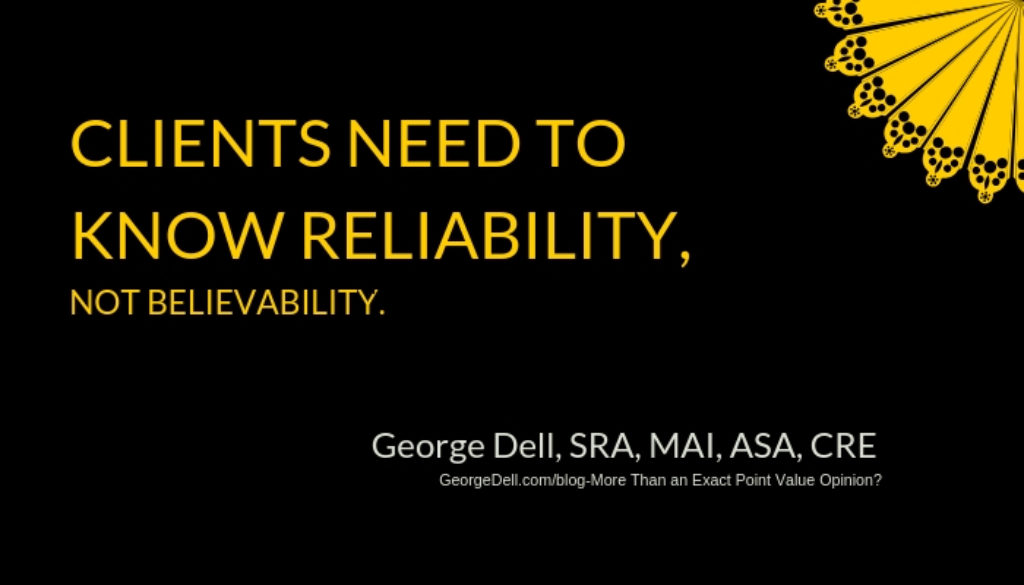Vintage appraisal focuses on a point value opinion. In reality, clients need help with estimating collateral risk, or investment potential.
Risk or reliability, if measured, is the uncertainty of the analyzed result, or the opinion of value.
Lenders, investors, portfolio managers today are aware of the power of today’s technology. They need a measure of risk, reliability, in a data stream format. They need a forecast of tomorrow’s recovery price, of income, or of liquidity. Clients need more than a judgment of recent history. They need documented research, visible analysis, and a reproducibility check.
Users do not need another credibility opinion of a ‘believable’ report, by a credible reviewer discussing believability. This is evidenced by the checklists, by the automated “Collateral Underwriter”. Underwriters rely on this review that is not a review. It is not a review because decisions are not made by a licensed appraiser, but by an automated engine. Based on this, the human underwriter, or not-an-appraiser person, makes an opinion decision on whether the appraisal is “quality” and believable.
USPAP (Uniform Standards of Professional Appraisal Practice), published by the Appraisal Foundation— “Authorized by Congress as the Source of Appraisal Standards and Appraiser Qualifications” defines credible as “worthy of belief.”
Unfortunately, there’s not one word about reliability of the result. Only believability. With one exception: in the development standards, it requires that the appraiser reasonably believes [sources of data] are reliable. And it must be a reasonable belief. This reasonableness to be judged by the credible opinion of an appraisal reviewer, under USPAP review standards. If a review is reviewed, of course that review must be believable in its opinion of the believability of the opinion of review of the opinion of the opinion of the original appraiser. Yes. Now breathe . . .
Clients need to know reliability, not believability. Clients need to rely on results. Measurable risk. Engineers, doctors, plumbers, and traffic safety analysts measure risk or reliability.
Risk Assessment is key. Not historical price. Results, not opinions.
Risk and reliability are opposite sides of the same dollar bill. For any analysis, any valuation, any scientific or artful study – expected reliability results may be:
- Ignored
- Guessed at
- Expertly estimated
- Analytically calculated
Where is appraisal today?
In several upcoming issues we will explore this issue, and how appraisers can become Asset Analysts. How collateral investors, initiators, underwriters, and portfolio managers can be provided a measure of risk and reliability. How we can work away from an opinion of believability to a measure of reliability. From checklist paperwork, to genuine decisioning input.
We will also provide deeper more analytic investigation and methods and tools in TAAR (The Asset Analyst Report), directed toward appraisers who want to become Asset Analysts. Similarly, for lenders, underwriters, portfolio and liquidity managers, the upcoming CIAR (Collateral Investor Assay Report) will provide guidance on methods for seamless integration of analyst results into banking and investment management systems.

February 13, 2019 @ 7:26 am
You touch on an important point – what is the risk associated with the value estimate? A property in a conforming market with lots of data valued at $1 million has far less risk than a unique or special-purpose property valued at $1 million. Richard Ratcliff made this point decades ago when he advocated for value as a probability distribution, and many respected authors have subsequently presented compelling arguments for something similar. At a minimum, providing an informed range of likely value would be a useful adjunct to simply providing a point estimate and calling it a day.
February 13, 2019 @ 8:36 am
Ive often read or heard you speak of reliability, take it a step further and lets get some brainstorming for such a reliability score. Then lets hear what is acceptable under reliablility 70,80,90%???
Please expand with some real world ideas that can be used now to set us ahead in thwe game.
February 18, 2019 @ 2:45 pm
Relative to “credible” vs “reliable”, “The Appraisal of 75 N. Pinckney”, by Dr. James A. Graaskamp, demonstrates the kind of extensive research and focused analyses necessary to derive not merely a credible value opinion, but a reliable one, as well. His value conclusions are reliable since another appraiser could take his data, replicate it, and reach more or less the same conclusions as did Dr. Graaskamp. He also shows that subjective or rule-of-thumb adjustments are neither credible nor reliable. It is my fervent hope that the real estate appraisal industry has not gotten so far “out in the weeds” that we, its practitioners, cannot recall it. George’s calls to produce reliable appraisals, not merely credible appraisals, is one man’s attempt to do just that. Thanks, George!
Appraisal Opinion vs Analytic Results? - George Dell, SRA, MAI, ASA, CRE
June 7, 2023 @ 1:15 am
[…] (in standard practice) provides only a point value, with no indication of uncertainty or risk, although it does require a reconciliation of […]